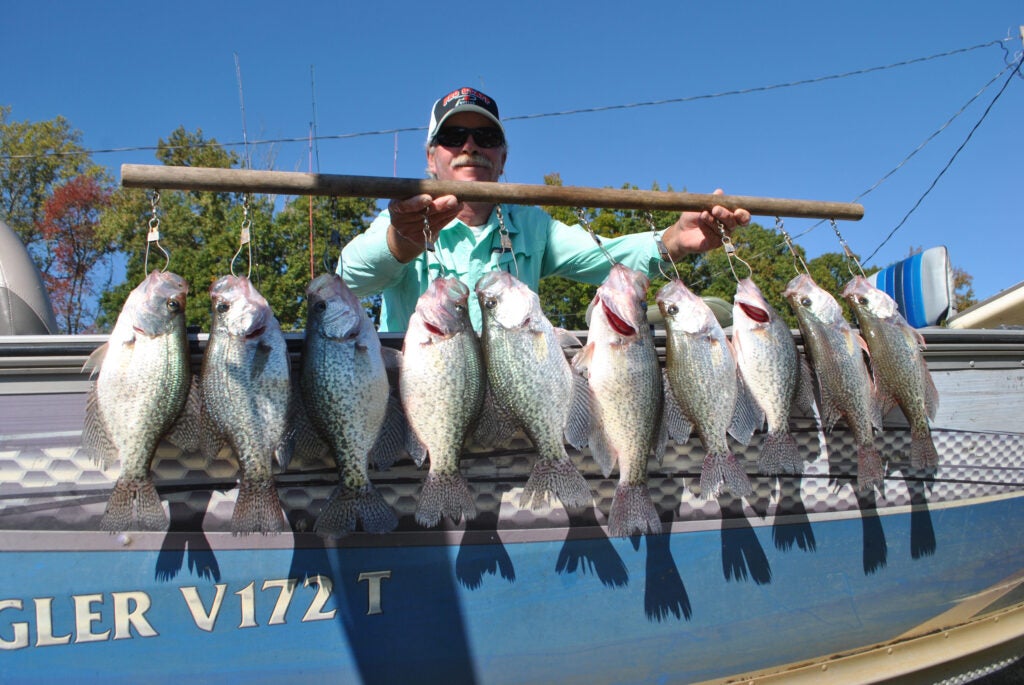Wanna step outside? Springtime crappie fishing is hard to beat, according to these three experts
Published 12:00 am Thursday, March 21, 2024

- Guide Chris Bullock likes to target crappie that are getting ready to spawn but haven't spread out in shallow water yet. They'll be in bigger concentrations and always be hungry. - Dan Kibler
|
Getting your Trinity Audio player ready...
|
By Dan Kibler
For Clemmons Courier
The dogwoods aren’t blooming yet — the traditional, age-old sign that the crappies are spawning — but the buds are starting to show, meaning fishermen around North Carolina’s Piedmont need to be on the water drowning minnows or dragging jigs for one of the best-tasting fish that freshwater has to offer.
The water temperature in area lakes is around the 60-degree mark, which pretty much opens the door for black and white crappie to begin the reproductive duties that put them in range of fishermen with boats as simple as aluminum jon boats to $70,000 bass boats with multiple rod-holders bristling with dozens of rods.
Guide Chris Bullock of Fountain and crappie pros Kenny Allen of Brown Summit and Ed Duke of Concord all look forward to March and April for consistently good action, but they all understand how the fishing can change on almost a daily basis.
All three concentrate on fish that are preparing to spawn because they’re concentrated in smaller areas and tend to be at their largest size. They hang around the edge of creek channels, usually in good-sized schools, until they get the urge to spawn and race into the shallows, spreading out to find their delivery rooms.
Duke said that fish will pick a creek and then a flat on which to spawn. At that point, fish will be hanging around deep water until the urge overcomes them. But just as fast, the urge can disappear, if weather or water conditions change.
“The biggest thing is, starting in late February and going through March, is never rule out a crappie being shallow,” said Duke, whose company, Southern Crappie Rods, provides tackle designed just for crappie. “They won’t spawn until the water temperature is in the 60s. But they’ll get up on that flat and make some false spawning runs. If a real cold front comes through, they may move back to deep water. But once they get on their spawning flat, they’ll stay there until it’s time.”
Allen, who has fished crappie tournaments around the Southeast for years, said the spawn can last for a good 6 weeks, with fish moving in and out at different times as conditions change.
“The first of March (one year), I had 13 2-pound fish in one day,” Allen said. “The bigger fish come in and out at different times, but I think the biggest fish have spawned by the first of April.
“The black crappie come in first and make their beds, then the whites. They’ll be about a week apart. You usually don’t catch blacks and whites together in March, but when you find the whites, they’re there.”
Bullock, whose Kerr Crappie and Cats Guide Service operates on John H. Kerr (Buggs Island) reservoir on the Virginia/North Carolina border, knows that the water warms earlier and later on different parts of the 49,500-acre reservoir he fishes, which leads him to target different parts of the lake.
“The spawn starts up around Clarksville (Va.), and it progresses downstream,” Bullock said. “They spawn first up there, then they work their way down.”
When they’re waiting for conditions to get “right,” Bullock finds big concentrations of crappie hanging out on brush piles next to the channels crappie use to move in and out of creeks. His best days have been when fish are on brush before they move to shallow water to spawn.
“I love to catch ‘em when they’re offshore, when they’re active,” he said. “That’s when you can catch lots of them in each place, but it doesn’t take ‘em long to go from brush to where they’re gonna spawn. Maybe they can make it in one day. They can be halfway out one day, in the back of the creek the next. If you can catch ‘em before they move, they’ll be feeding.”
Allen uses a multiple-rod setup known as “spider-rigging.” He’ll pull soft-plastic baits on tiny jigs on anywhere from eight to 12 rods of different lengths, enabling him to spawn a swath of water maybe 40 feet wide. Depending on how fast his trolling motor pulls the boat along — and the weight of his jigs (commonly ⅛- down to 1/64-ounce) — he can fish different depths.
When he locates a concentration of fish, he can easily figure out the depth they’re holding and which lure colors they prefer, enabling him to make repeated passes through the area, catching fish every time.
“You’ll catch some big fish early, but most of the time, they’re better up in the day,” said Allen, who usually trolls at about 1 mph. “I’ve seen it slow in the morning, then I had to speed the boat up later in the day because they’d gotten so active.”
Because he keys so much on brush piles, Bullock typically casts jigs and soft plastics or jigs tipped with minnows, using light-action spinning tackle. He pinpoints a brush pile on his depth finder, sees the arcs scattered in the water around the brush that signify fish, then casts and counts his bait down as it sinks to the proper depth, usually one second per foot. Then, he’ll begin his slow retrieve.
If he catches a fish or two quickly, he’ll spend more time on that brushpile — which may only be good for that day before fish leave it and move shallow. If they’ve left the next day, he’ll work creeks that are farther down the lake, because they warm a little later and the fish will go to the bank to spawn a little later.
Duke said that experience fishing particular lakes is a tremendous advantage because there are areas scattered across a reservoir that crappie prefer to use when the spawn approaches — leaving other areas vacant. They’re usually in the back of a creek or cove, he said, where the current doesn’t come into play, with a gravel bottom.
“You’ve got to have that combination,” he said.
Find one or two of those areas, and you’re good to go for several weeks of good fishing.




